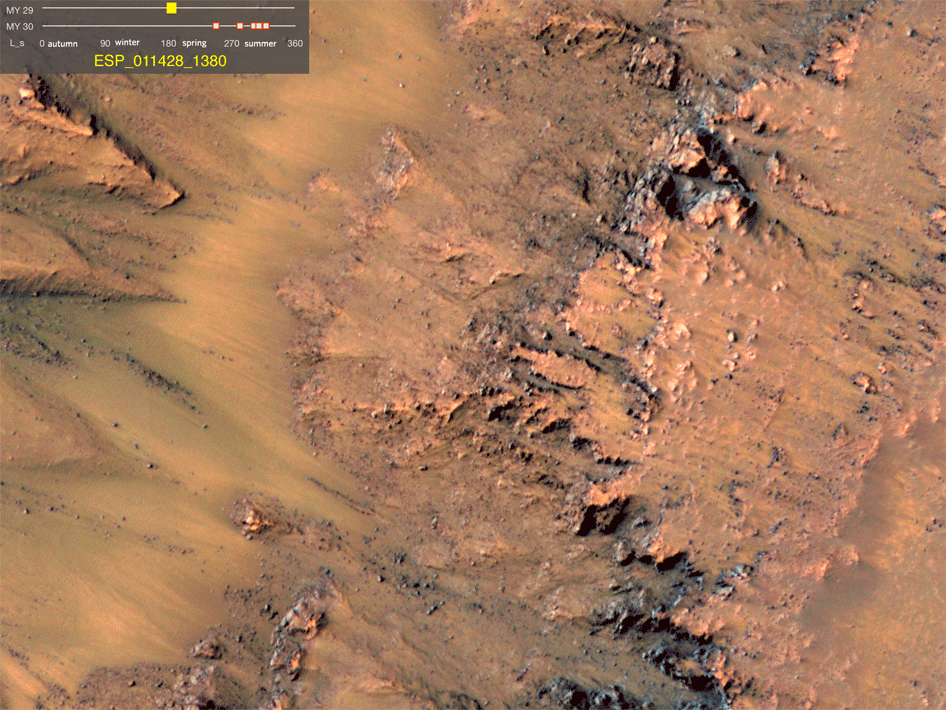
Warm-Season Flows on Slope in Newton Crater – Credit: NASA
Cliccare sulla foto per ingrandirla – Click on image to enlarge
Il 5 Agosto del 2011 la Nasa pubblicò i risultati delle evidenze relative a quella che allora era la possibile interpretazione della presenza di acqua su Marte, ora confermata nella conferenza di ieri, annunciata poco prima. Questa serie di immagini montate in sequenza mostrano lo scorrere di acqua salata ottenute dalla sonda Mars Reconnaissance Orbiter attraverso la telecamera ad alta risoluzione “High Resolution Imaging Science Experiment” (HiRISE). Le immagini si riferiscono al cratere Newton e lo studio è stato reso noto il 5 agosto del 2011 dalla rivista Science.
La sequenza in serie parte dalla primavera di un anno su Marte fino a metà estate dell’anno successivo. Le immagini sono state adeguate per correggere quelle riprese da angolazioni oblique e mostrare come la scena apparirebbe se guardassimo dall’alto. Le caratteristiche che si estendono lungo il pendio durante le stagioni calde sono chiamate linee in pendenza ricorrenti. Esse sono piuttosto strette (la metà di cinque yard o metri di larghezza), le marcature relativamente scure si estendono su pendii (da 25 a 40 gradi) in diverse località poste a sud. Le immagini in sequenza di HiRISE mostrano le caratteristiche che appaiono e che si incrementano durante le stagioni calde, per diminuire durante le stagioni fredde. Si estendono da affioramenti granitici, spesso associati a piccoli canali, e solo un centinaio di loro si sono osservati in altri luoghi. Essi appaiono e si allungano in primavera e durante l’estate prevalentemente a sud, a latitudini che vanno da 48 gradi a 32 gradi. In questi precisi periodi e luoghi si hanno temperature superficiali di picco di circa 10 gradi sotto zero Fahrenheit a 80 gradi sopra lo zero Fahrenheit (circa 250 a 300 Kelvin). Brina liquida vicino alla superficie può spiegare questa attività, ma l’esatto meccanismo e la fonte dell’acqua non sono compresi. La serie è montata con un tempo di stop di due secondi sul primo e l’ultimo fotogramma e di un secondo sui fotogrammi intermedi, anche se la rete o le prestazioni del computer possono causare delle variazioni.
This series of images shows warm-season features that might be evidence of salty liquid water active on Mars today. Evidence for that possible interpretation is presented in a report by McEwen et al. in the Aug. 5, 2011, edition of Science. These images come from observations of Newton crater, at 41.6 degrees south latitude, 202.3 degrees east longitude, by the High Resolution Imaging Science Experiment (HiRISE) camera on NASA’s Mars Reconnaissance Orbiter.
In time, the series spans from early spring of one Mars year to mid-summer of the following year. The images have been adjusted to correct those taken from oblique angles to show how the scene would look from directly overhead. The features that extend down the slope during warm seasons are called recurring slope lineae. They are narrow (one-half to five yards or meters wide), relatively dark markings on steep (25 to 40 degree) slopes at several southern hemisphere locations. Repeat imaging by HiRISE shows the features appear and incrementally grow during warm seasons and fade in cold seasons. They extend downslope from bedrock outcrops, often associated with small channels, and hundreds of them form in rare locations. They appear and lengthen in the southern spring and summer from 48 degrees to 32 degrees south latitudes favoring equator-facing slopes. These times and places have peak surface temperatures from about 10 degrees below zero Fahrenheit to 80 degree above zero Fahrenheit (about 250 to 300 Kelvin). Liquid brines near the surface might explain this activity, but the exact mechanism and source of the water are not understood. The series is timed to dwell two seconds on the first and last frames and one second on intermediate frames, though network or computer performance may cause this to vary.
Source/Continue reading → NASA.gov























Pingback: NASA Conferma: C’è Acqua Liquida Salata su Marte! – Mars Has Salty Flowing Water! | DENEB Official ©